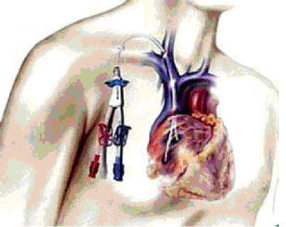 Definition
Definition
The catheter is a soft hollow plastic tube that the doctor inserts in the vein of the neck (the jugular vein), chest (subclavian vein) or groin (femoral vein). Inserted temporarily or permanently, it serves as access for performing a dialysis.
Temporary catheter
It can be used immediately after placement. Reserved to hemodialysis procedures, this catheter may be used temporarily in emergency cases or until the creation of a fistula.
It can be maintained from 10 days to 3 weeks. It is placed under local anesthesia by experienced nephrologists. The operation lasts from 30 to 45 minutes. A dressing is thereafter placed and must be permanently kept.
At the end of the procedure, X-ray control may be performed to check the position of the catheter in the vein.
Tunneled catheter
This catheter constitutes a permanent access for the dialyzer, when all possibilities of creating fistulas were eliminated. The permanent catheter is inserted in the operating site, under local anesthesia, by experienced nephrologists. During the placement, a tunnel is made under the skin in order to reduce as much as possible the risks of infection.
The intervention lasts about one hour. A dressing is then placed and should not be removed. An X-ray control shall be made after the placement in order to check its positioning.
Monitoring and healthcare recommendations
They are valid for the two types of catheters:
- make sure that your dressing is replaced at each dialysis
- do not moisten the catheter dressing (adapted hygiene care)
- keep at all times the dressing clean and closed
- avoid pulling on the catheter
- in case of pain, temperature, itching and/or discharges at the catheter level, immediately alert your hemodialysis center (according to the emergency procedures)
